Strategic Management Accounting Report: Comparing Costing Systems
VerifiedAdded on 2023/01/18
|7
|779
|58
Report
AI Summary
This report focuses on strategic management accounting, specifically analyzing overhead allocation methods. It begins by defining overhead costs and differentiating between traditional, volume-based, and activity-based costing systems. The report highlights the limitations of traditional methods and emphasizes the rationality and accuracy of activity-based costing (ABC). A case study of Lehigh Steel is presented, illustrating the application of ABC. The analysis includes calculations of activity rates and overhead costs per unit, demonstrating the superiority of ABC in capturing the impact of various activities on total overhead costs. The report concludes that ABC is a more appropriate and advanced method compared to traditional volume-based costing. References and bibliography are also included.
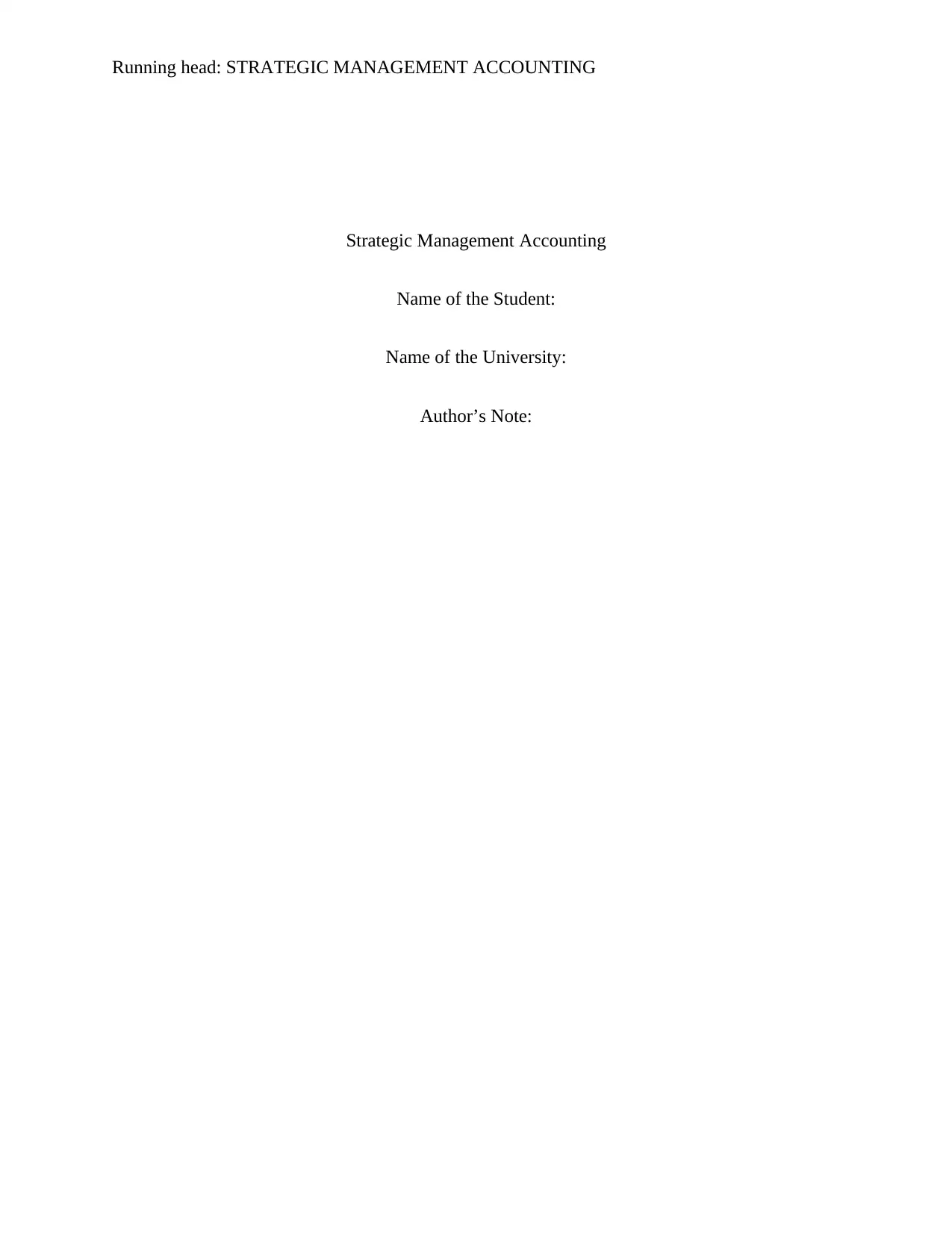
Running head: STRATEGIC MANAGEMENT ACCOUNTING
Strategic Management Accounting
Name of the Student:
Name of the University:
Author’s Note:
Strategic Management Accounting
Name of the Student:
Name of the University:
Author’s Note:
Paraphrase This Document
Need a fresh take? Get an instant paraphrase of this document with our AI Paraphraser
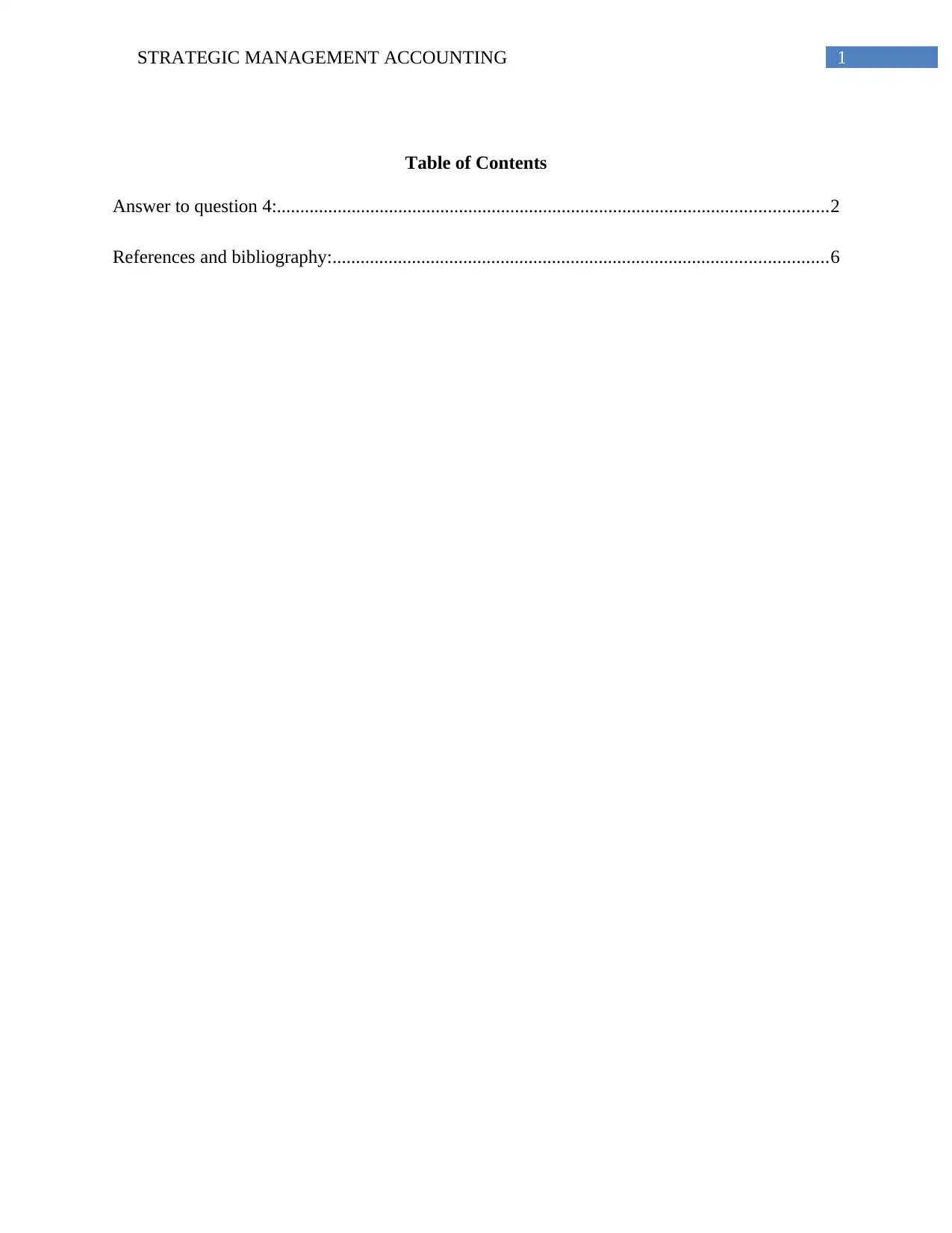
1STRATEGIC MANAGEMENT ACCOUNTING
Table of Contents
Answer to question 4:......................................................................................................................2
References and bibliography:..........................................................................................................6
Table of Contents
Answer to question 4:......................................................................................................................2
References and bibliography:..........................................................................................................6
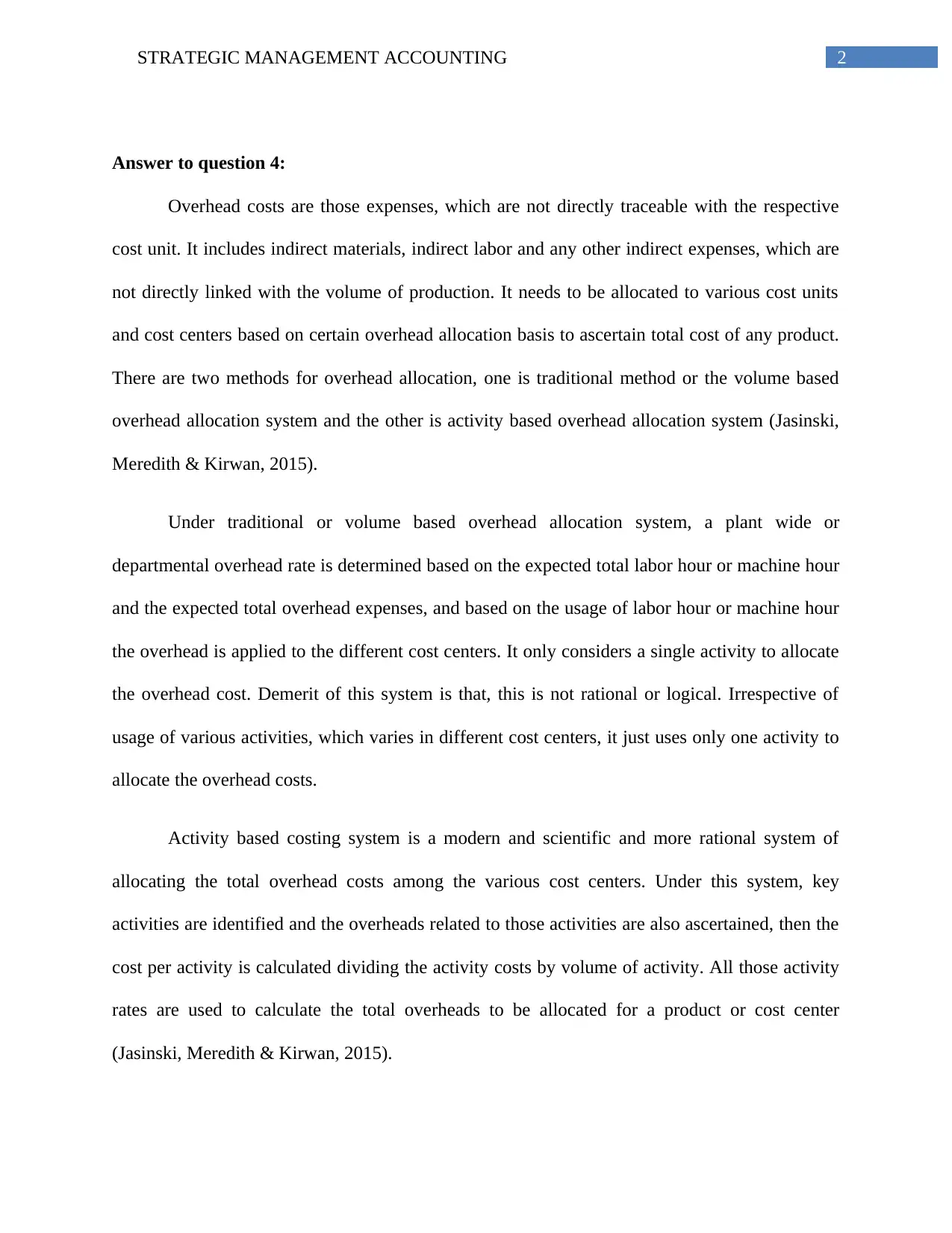
2STRATEGIC MANAGEMENT ACCOUNTING
Answer to question 4:
Overhead costs are those expenses, which are not directly traceable with the respective
cost unit. It includes indirect materials, indirect labor and any other indirect expenses, which are
not directly linked with the volume of production. It needs to be allocated to various cost units
and cost centers based on certain overhead allocation basis to ascertain total cost of any product.
There are two methods for overhead allocation, one is traditional method or the volume based
overhead allocation system and the other is activity based overhead allocation system (Jasinski,
Meredith & Kirwan, 2015).
Under traditional or volume based overhead allocation system, a plant wide or
departmental overhead rate is determined based on the expected total labor hour or machine hour
and the expected total overhead expenses, and based on the usage of labor hour or machine hour
the overhead is applied to the different cost centers. It only considers a single activity to allocate
the overhead cost. Demerit of this system is that, this is not rational or logical. Irrespective of
usage of various activities, which varies in different cost centers, it just uses only one activity to
allocate the overhead costs.
Activity based costing system is a modern and scientific and more rational system of
allocating the total overhead costs among the various cost centers. Under this system, key
activities are identified and the overheads related to those activities are also ascertained, then the
cost per activity is calculated dividing the activity costs by volume of activity. All those activity
rates are used to calculate the total overheads to be allocated for a product or cost center
(Jasinski, Meredith & Kirwan, 2015).
Answer to question 4:
Overhead costs are those expenses, which are not directly traceable with the respective
cost unit. It includes indirect materials, indirect labor and any other indirect expenses, which are
not directly linked with the volume of production. It needs to be allocated to various cost units
and cost centers based on certain overhead allocation basis to ascertain total cost of any product.
There are two methods for overhead allocation, one is traditional method or the volume based
overhead allocation system and the other is activity based overhead allocation system (Jasinski,
Meredith & Kirwan, 2015).
Under traditional or volume based overhead allocation system, a plant wide or
departmental overhead rate is determined based on the expected total labor hour or machine hour
and the expected total overhead expenses, and based on the usage of labor hour or machine hour
the overhead is applied to the different cost centers. It only considers a single activity to allocate
the overhead cost. Demerit of this system is that, this is not rational or logical. Irrespective of
usage of various activities, which varies in different cost centers, it just uses only one activity to
allocate the overhead costs.
Activity based costing system is a modern and scientific and more rational system of
allocating the total overhead costs among the various cost centers. Under this system, key
activities are identified and the overheads related to those activities are also ascertained, then the
cost per activity is calculated dividing the activity costs by volume of activity. All those activity
rates are used to calculate the total overheads to be allocated for a product or cost center
(Jasinski, Meredith & Kirwan, 2015).
⊘ This is a preview!⊘
Do you want full access?
Subscribe today to unlock all pages.

Trusted by 1+ million students worldwide
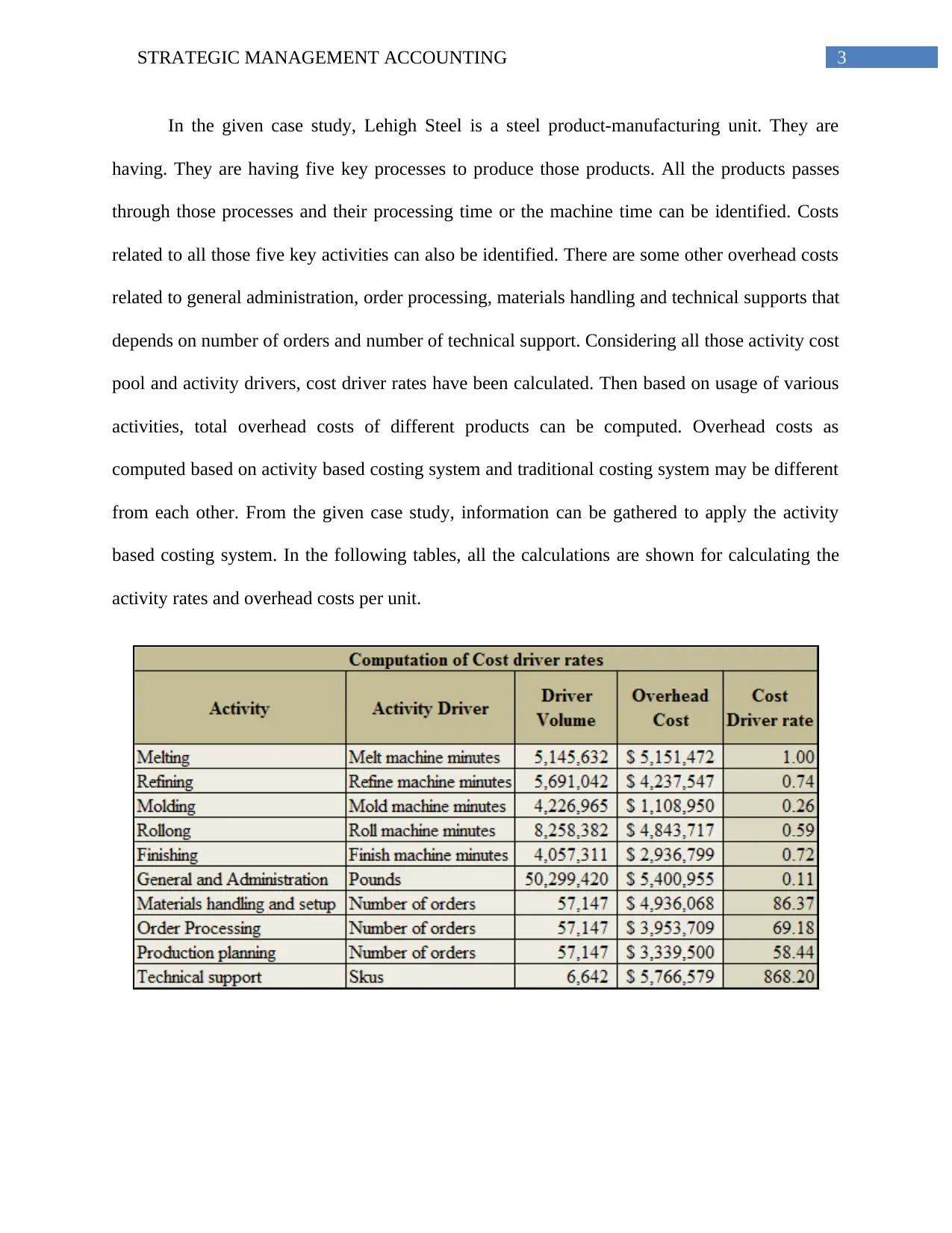
3STRATEGIC MANAGEMENT ACCOUNTING
In the given case study, Lehigh Steel is a steel product-manufacturing unit. They are
having. They are having five key processes to produce those products. All the products passes
through those processes and their processing time or the machine time can be identified. Costs
related to all those five key activities can also be identified. There are some other overhead costs
related to general administration, order processing, materials handling and technical supports that
depends on number of orders and number of technical support. Considering all those activity cost
pool and activity drivers, cost driver rates have been calculated. Then based on usage of various
activities, total overhead costs of different products can be computed. Overhead costs as
computed based on activity based costing system and traditional costing system may be different
from each other. From the given case study, information can be gathered to apply the activity
based costing system. In the following tables, all the calculations are shown for calculating the
activity rates and overhead costs per unit.
In the given case study, Lehigh Steel is a steel product-manufacturing unit. They are
having. They are having five key processes to produce those products. All the products passes
through those processes and their processing time or the machine time can be identified. Costs
related to all those five key activities can also be identified. There are some other overhead costs
related to general administration, order processing, materials handling and technical supports that
depends on number of orders and number of technical support. Considering all those activity cost
pool and activity drivers, cost driver rates have been calculated. Then based on usage of various
activities, total overhead costs of different products can be computed. Overhead costs as
computed based on activity based costing system and traditional costing system may be different
from each other. From the given case study, information can be gathered to apply the activity
based costing system. In the following tables, all the calculations are shown for calculating the
activity rates and overhead costs per unit.
Paraphrase This Document
Need a fresh take? Get an instant paraphrase of this document with our AI Paraphraser
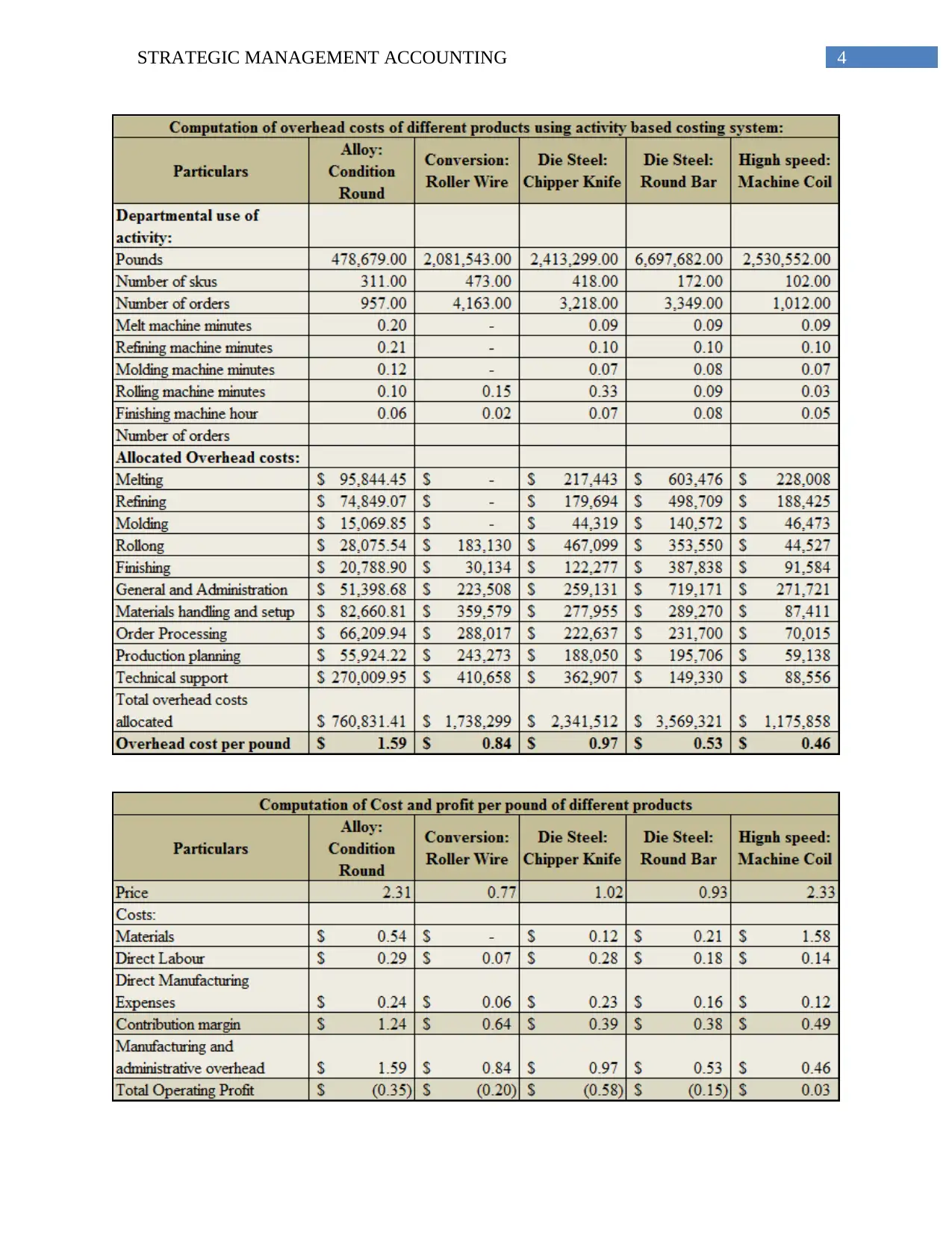
4STRATEGIC MANAGEMENT ACCOUNTING
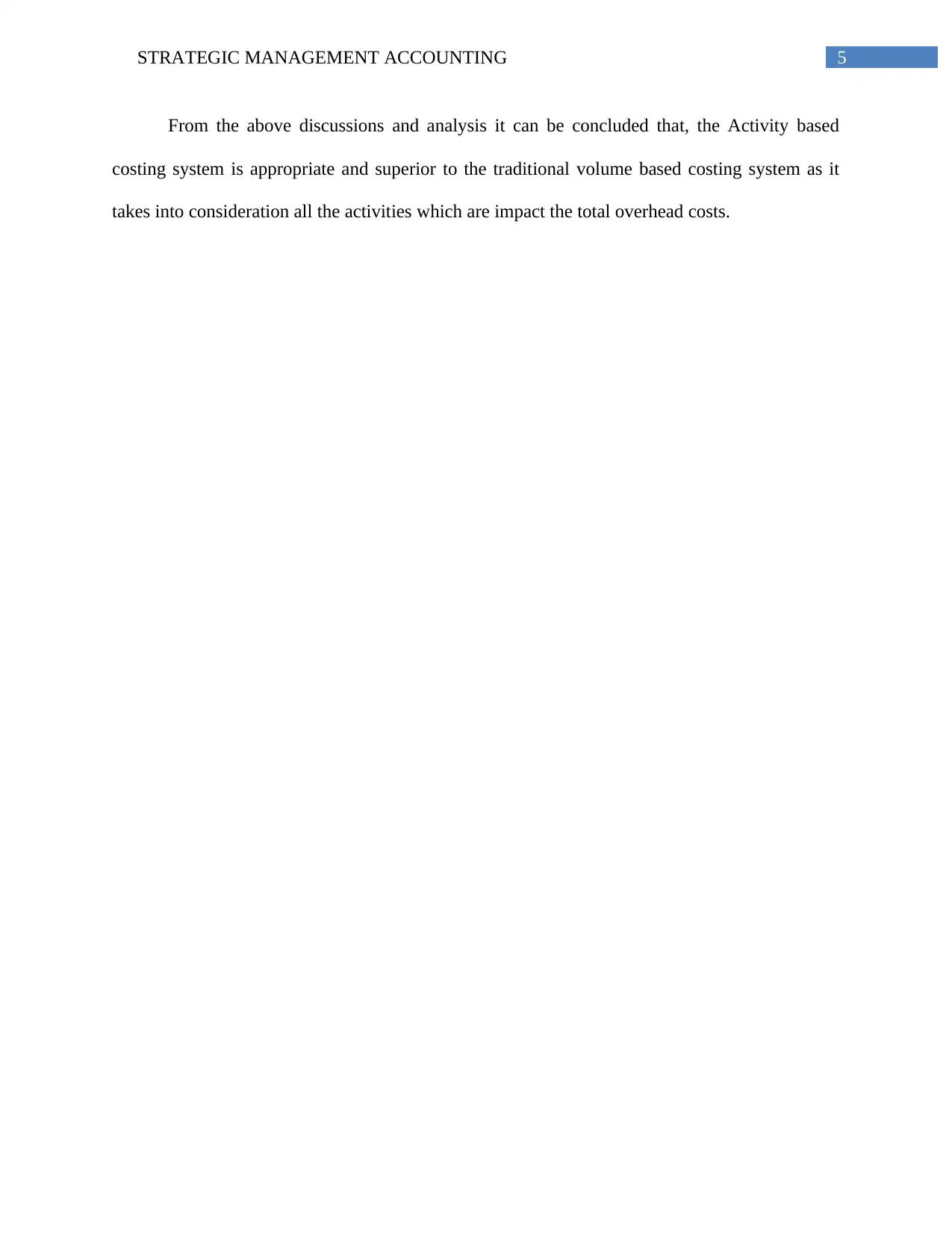
5STRATEGIC MANAGEMENT ACCOUNTING
From the above discussions and analysis it can be concluded that, the Activity based
costing system is appropriate and superior to the traditional volume based costing system as it
takes into consideration all the activities which are impact the total overhead costs.
From the above discussions and analysis it can be concluded that, the Activity based
costing system is appropriate and superior to the traditional volume based costing system as it
takes into consideration all the activities which are impact the total overhead costs.
⊘ This is a preview!⊘
Do you want full access?
Subscribe today to unlock all pages.

Trusted by 1+ million students worldwide
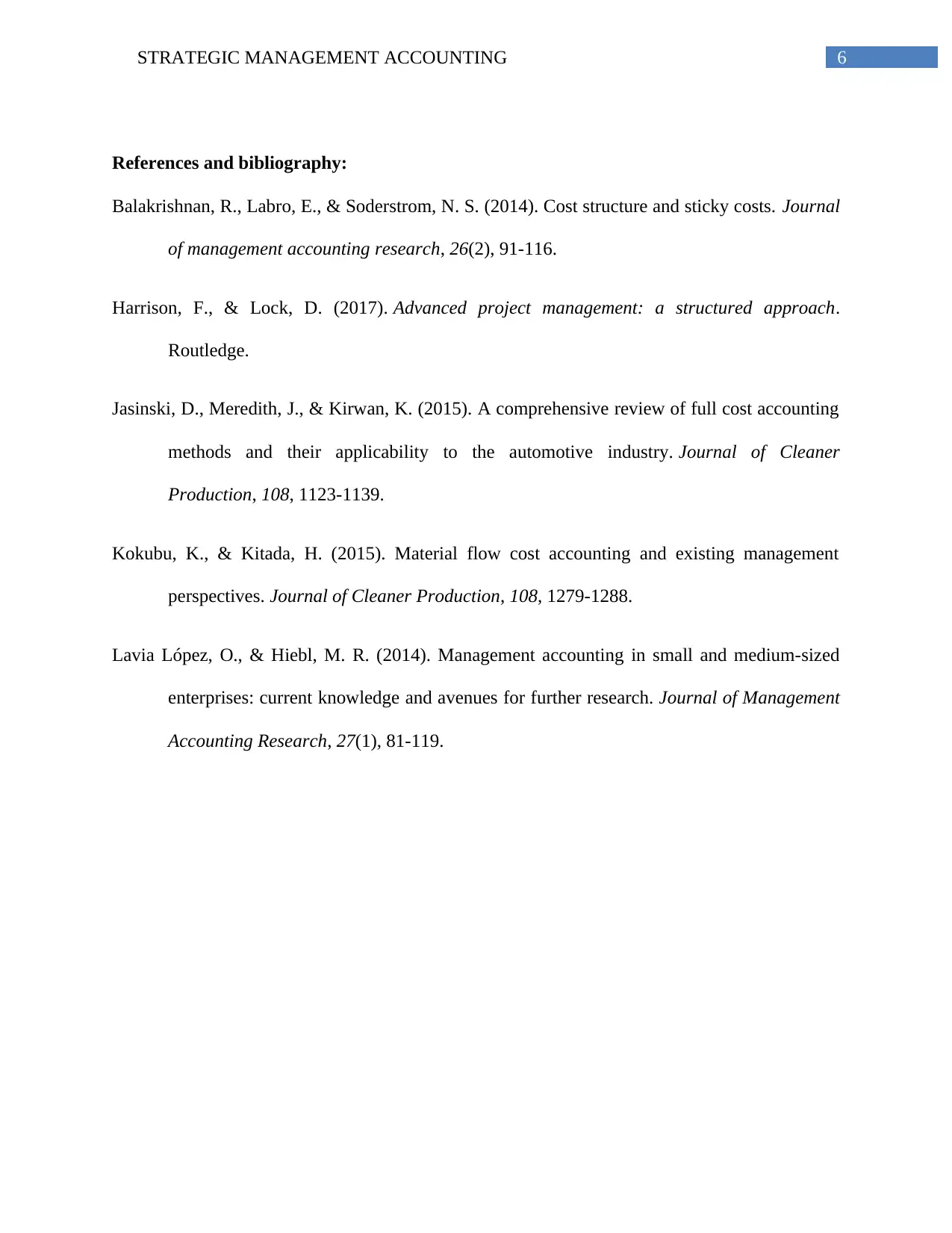
6STRATEGIC MANAGEMENT ACCOUNTING
References and bibliography:
Balakrishnan, R., Labro, E., & Soderstrom, N. S. (2014). Cost structure and sticky costs. Journal
of management accounting research, 26(2), 91-116.
Harrison, F., & Lock, D. (2017). Advanced project management: a structured approach.
Routledge.
Jasinski, D., Meredith, J., & Kirwan, K. (2015). A comprehensive review of full cost accounting
methods and their applicability to the automotive industry. Journal of Cleaner
Production, 108, 1123-1139.
Kokubu, K., & Kitada, H. (2015). Material flow cost accounting and existing management
perspectives. Journal of Cleaner Production, 108, 1279-1288.
Lavia López, O., & Hiebl, M. R. (2014). Management accounting in small and medium-sized
enterprises: current knowledge and avenues for further research. Journal of Management
Accounting Research, 27(1), 81-119.
References and bibliography:
Balakrishnan, R., Labro, E., & Soderstrom, N. S. (2014). Cost structure and sticky costs. Journal
of management accounting research, 26(2), 91-116.
Harrison, F., & Lock, D. (2017). Advanced project management: a structured approach.
Routledge.
Jasinski, D., Meredith, J., & Kirwan, K. (2015). A comprehensive review of full cost accounting
methods and their applicability to the automotive industry. Journal of Cleaner
Production, 108, 1123-1139.
Kokubu, K., & Kitada, H. (2015). Material flow cost accounting and existing management
perspectives. Journal of Cleaner Production, 108, 1279-1288.
Lavia López, O., & Hiebl, M. R. (2014). Management accounting in small and medium-sized
enterprises: current knowledge and avenues for further research. Journal of Management
Accounting Research, 27(1), 81-119.
1 out of 7
Related Documents
Your All-in-One AI-Powered Toolkit for Academic Success.
+13062052269
info@desklib.com
Available 24*7 on WhatsApp / Email
![[object Object]](/_next/static/media/star-bottom.7253800d.svg)
Unlock your academic potential
Copyright © 2020–2025 A2Z Services. All Rights Reserved. Developed and managed by ZUCOL.





